Boston Cream Donuts are fluffy fried donuts with a creamy custard filling and a decadent chocolate glaze.
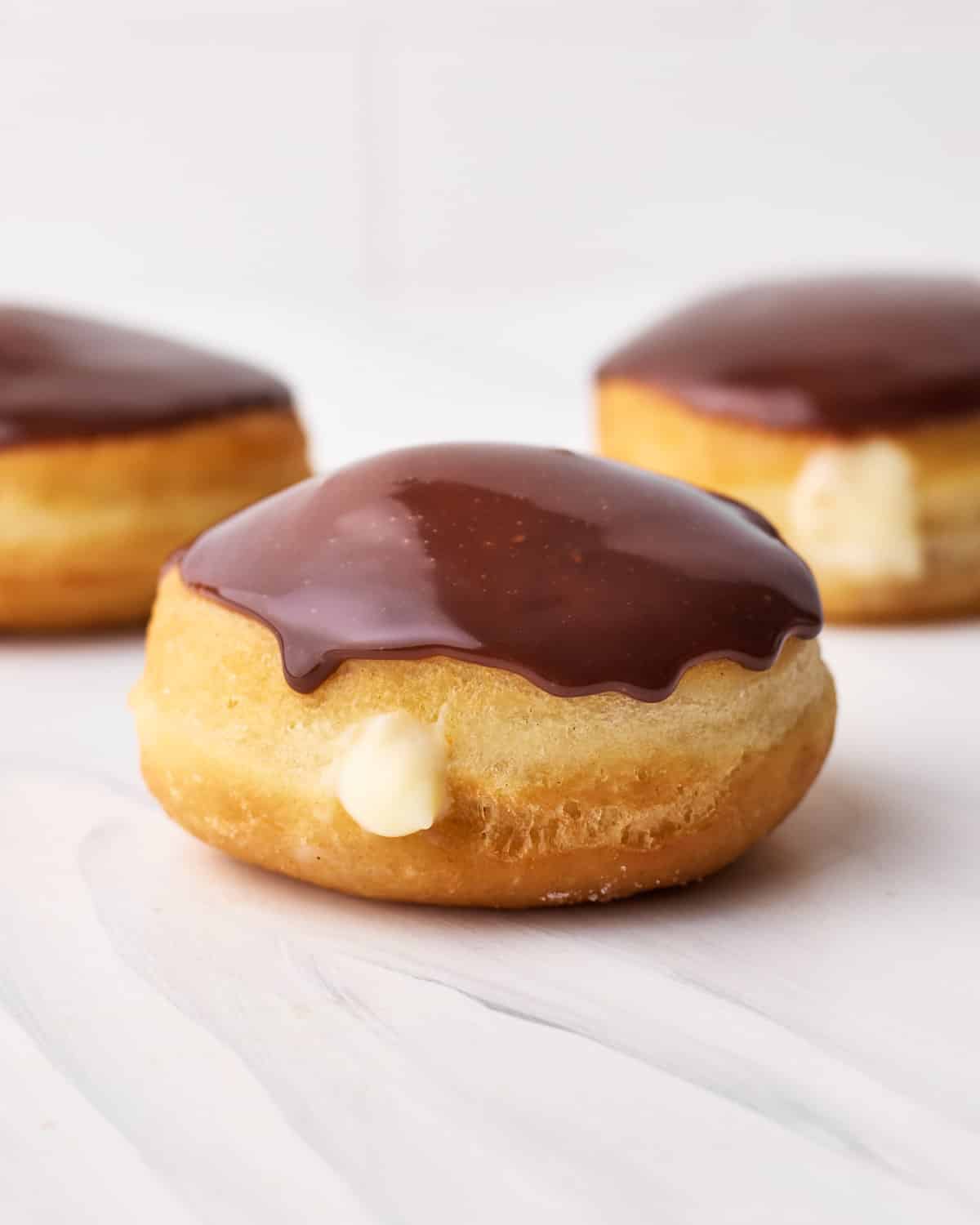
Homemade Boston Cream Donuts are impressive and indulgent, but surprisingly simple to make.
I break the whole process down into sections with lots of detail and tips to help you make the perfect homemade doughnuts, creamy filling, and rich chocolate glaze.
If you want to wow everyone with the best donuts they have ever had - keep reading!
Why You'll Love This Recipe
- Homemade donuts have better flavor and texture than donut shop ones.
- Easy recipe with expert tips and process pictures for the donuts, filling, and glaze
- Individual portioned version of classic Boston Cream Pie.
Ingredients
This Boston Cream Donut recipe has almost exactly the same ingredients as my Bavarian Cream Donuts, so you could make both at the same time if you like!
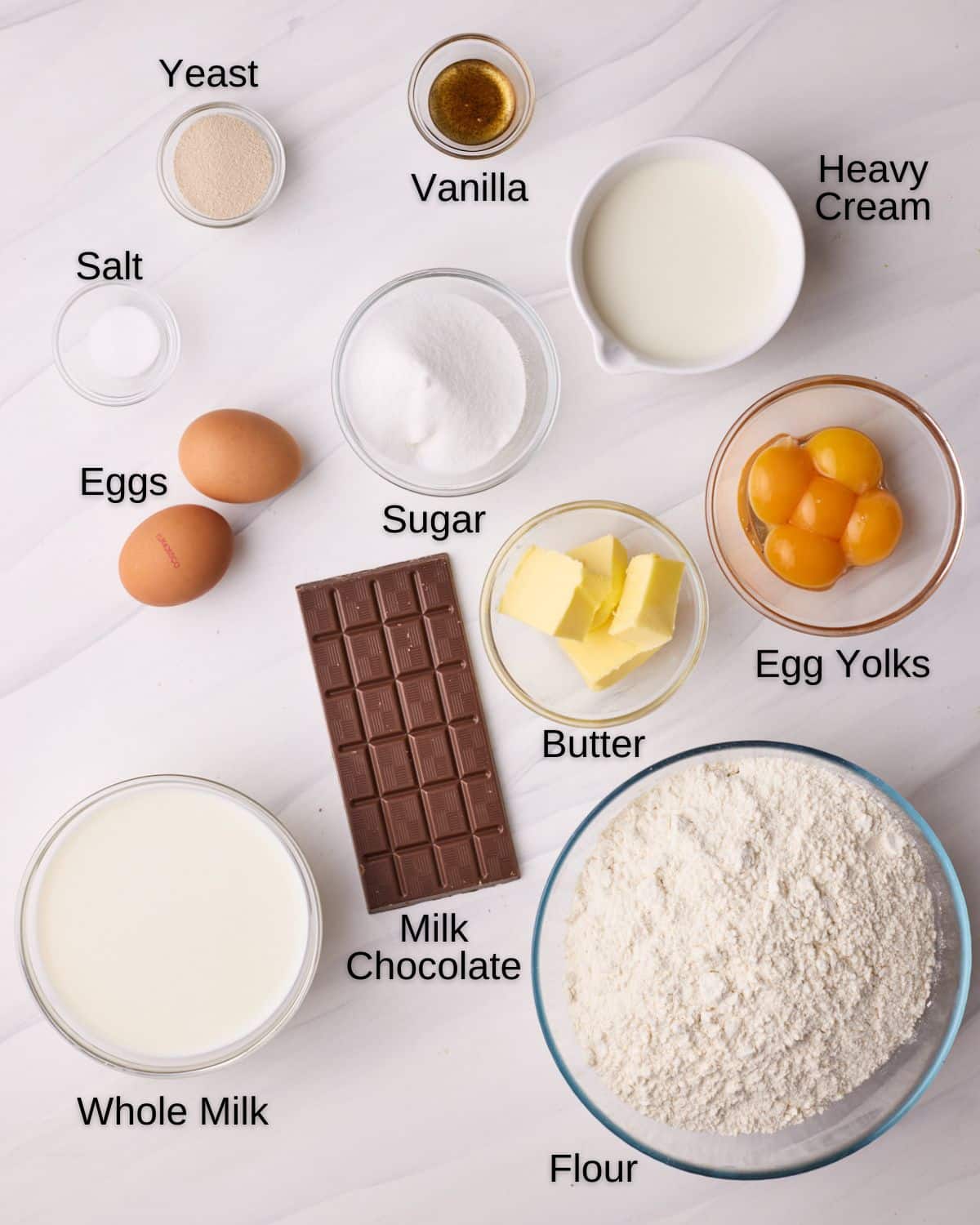
- Eggs - Use large eggs. We'll use whole eggs for the donut dough and egg yolks for the custard filling.
- Sugar - Regular white sugar, preferably superfine (caster sugar).
- Milk - For best results, use whole milk. Pastry cream needs the fat content in order to thicken and carry flavor.
- Butter - Unsalted butter for both the donuts and filling.
- Cornstarch - Starch helps the pastry cream to thicken.
- Vanilla - Vanilla extract or vanilla bean paste. I like the paste because you can see little specs of vanilla in the custard.
- Flour - All-purpose flour.
- Yeast - Active dry yeast or instant yeast. If you use instant yeast there is no need to activate it in the milk mixture.
- Chocolate - The glaze is a rich chocolate ganache, so use high-quality chocolate, not chocolate chips. Use semi-sweet or milk chocolate.
- Heavy Cream - Use heavy cream, heavy whipping cream, or double cream. Anything else won't have sufficient fat content.
- Frying Oil - I use vegetable oil for frying, but you can use another flavorless oil if you prefer.
See the recipe card for quantities.
How to Make Homemade Donuts
Homemade doughnuts may seem daunting if you have never made them before, but it's actually quite easy to make your own donuts as long as you follow the recipe closely and pay attention to my tips for success.
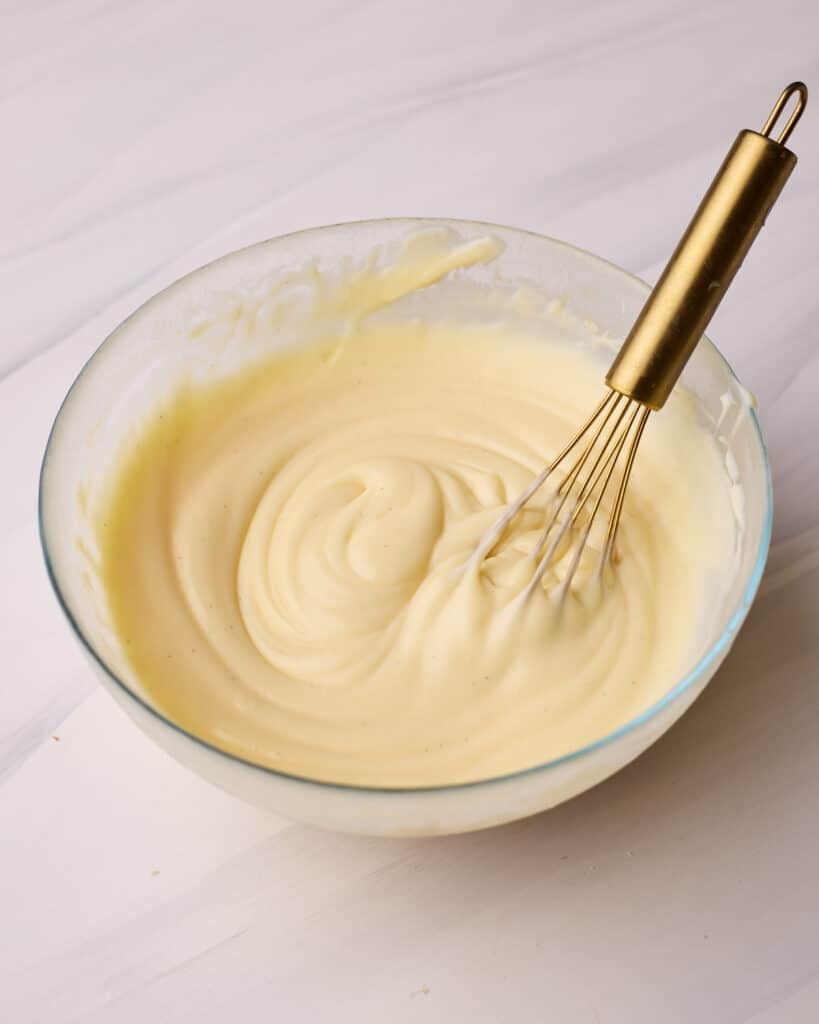
Make the Filling
Make the pastry cream filling first as it needs to chill for at least 2 hours. I like to make it the day before so the vanilla flavor can develop overnight.
I have a detailed post about how to make the best vanilla pastry cream, so check that out for extra tips.
Put it in a medium bowl and cover with plastic wrap that touches the surface. Refrigerate until needed.
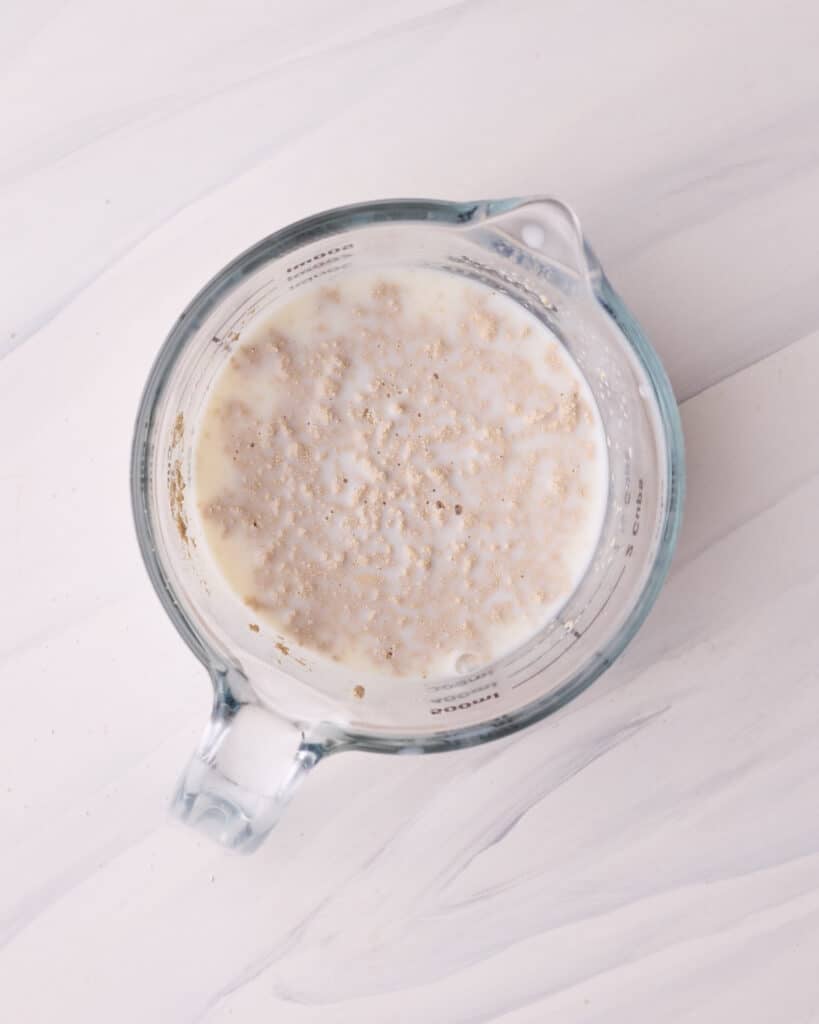
Activate the Yeast
Microwave the milk until it is lukewarm, then mix the dry yeast and a tablespoon of the sugar into the warm milk and let sit for 5-10 minutes until it starts to froth.
If you are using instant dry yeast you can skip this step.
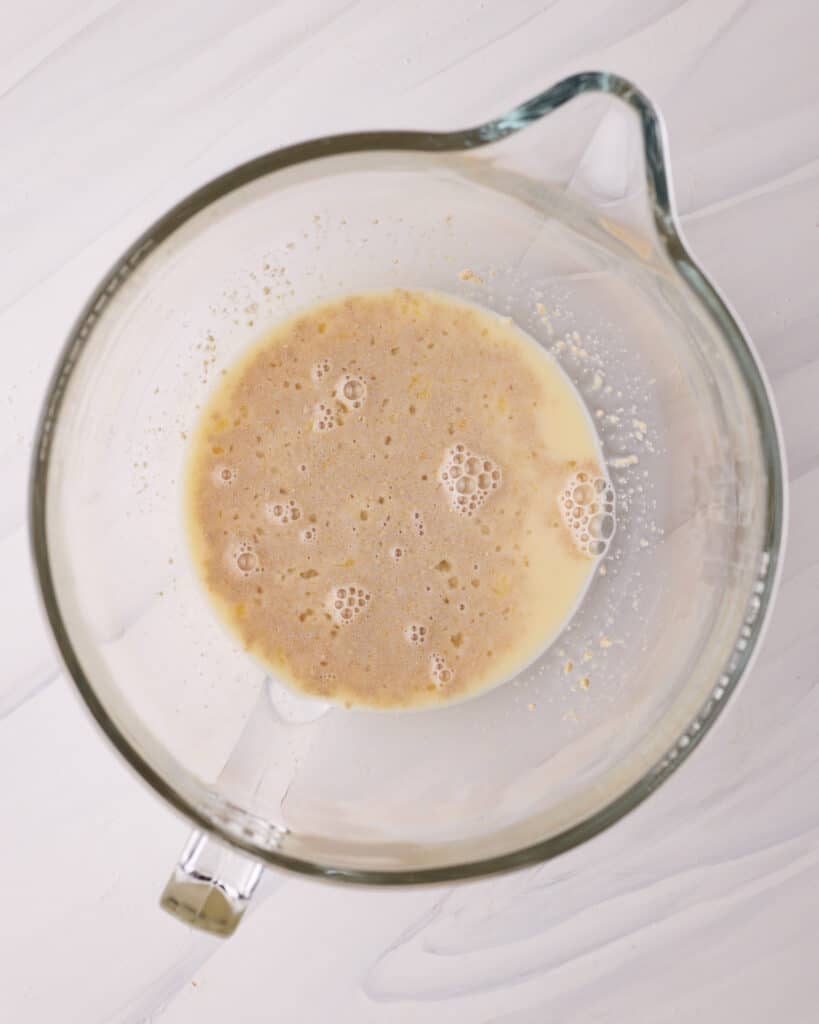
Wet Ingredients
Whisk together the eggs, sugar, and salt in the bowl of a stand mixer, then add the milk/yeast mixture bowl and whisk to combine.
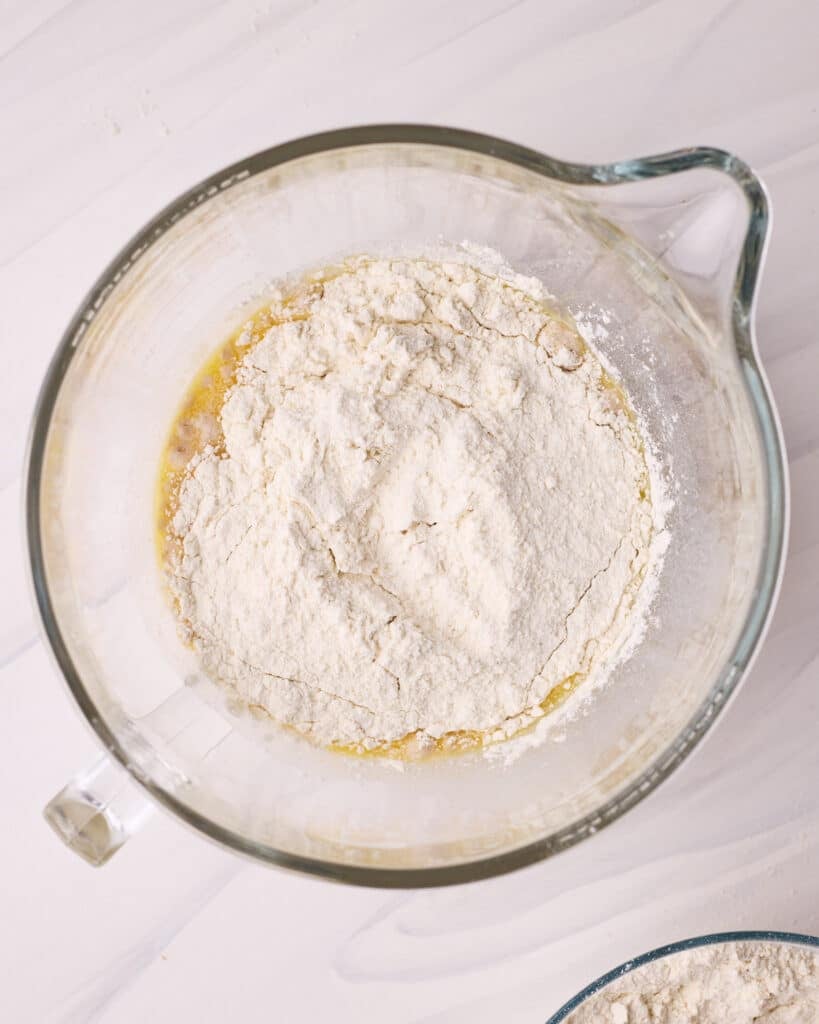
Hydrate the Flour
Add the flour to the bowl and turn the mixer on low speed with the dough hook for 1 minute.
Continue to mix on low and slowly drizzle the melted butter into the bowl.
Measuring Ingredients: It's best to weigh your ingredients with a kitchen scale. Measuring with cups is not very accurate and this can completely ruin your desserts.
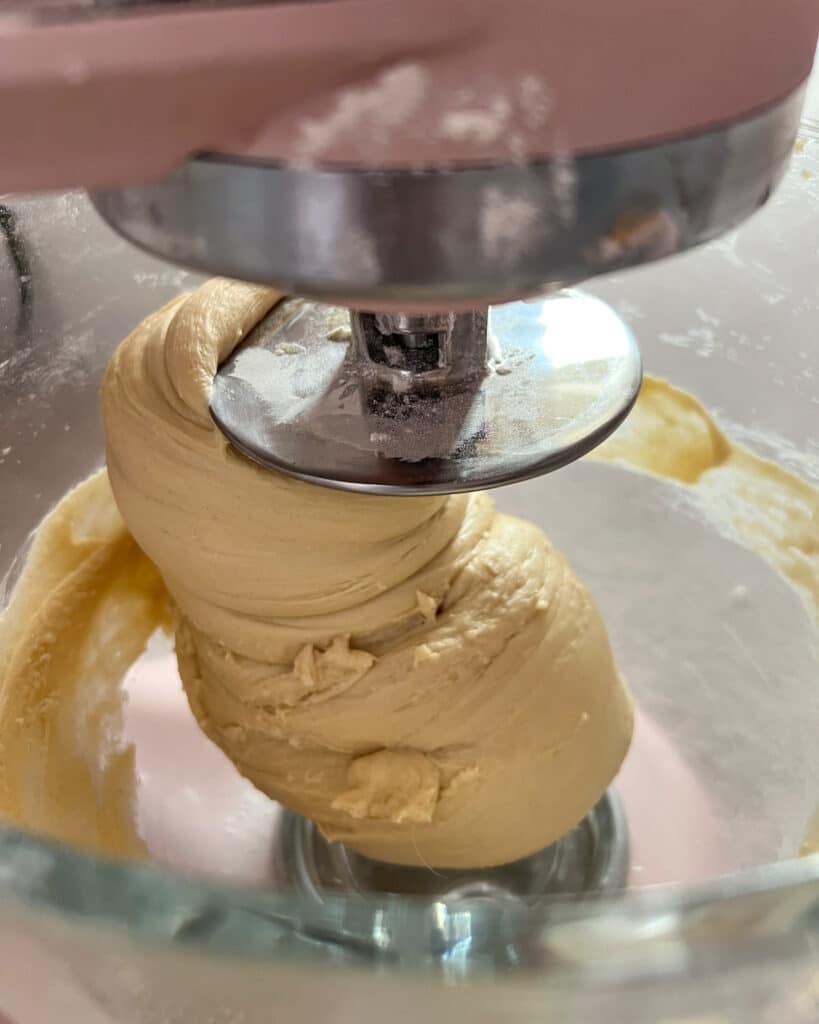
Knead the Dough
Turn the speed up to medium-high for 3-5 minutes or until the dough is no longer sticking to the sides of the bowl.
Tip the dough onto a lightly floured surface and knead by hand until it doesn't feel sticky.
Windowpane Test
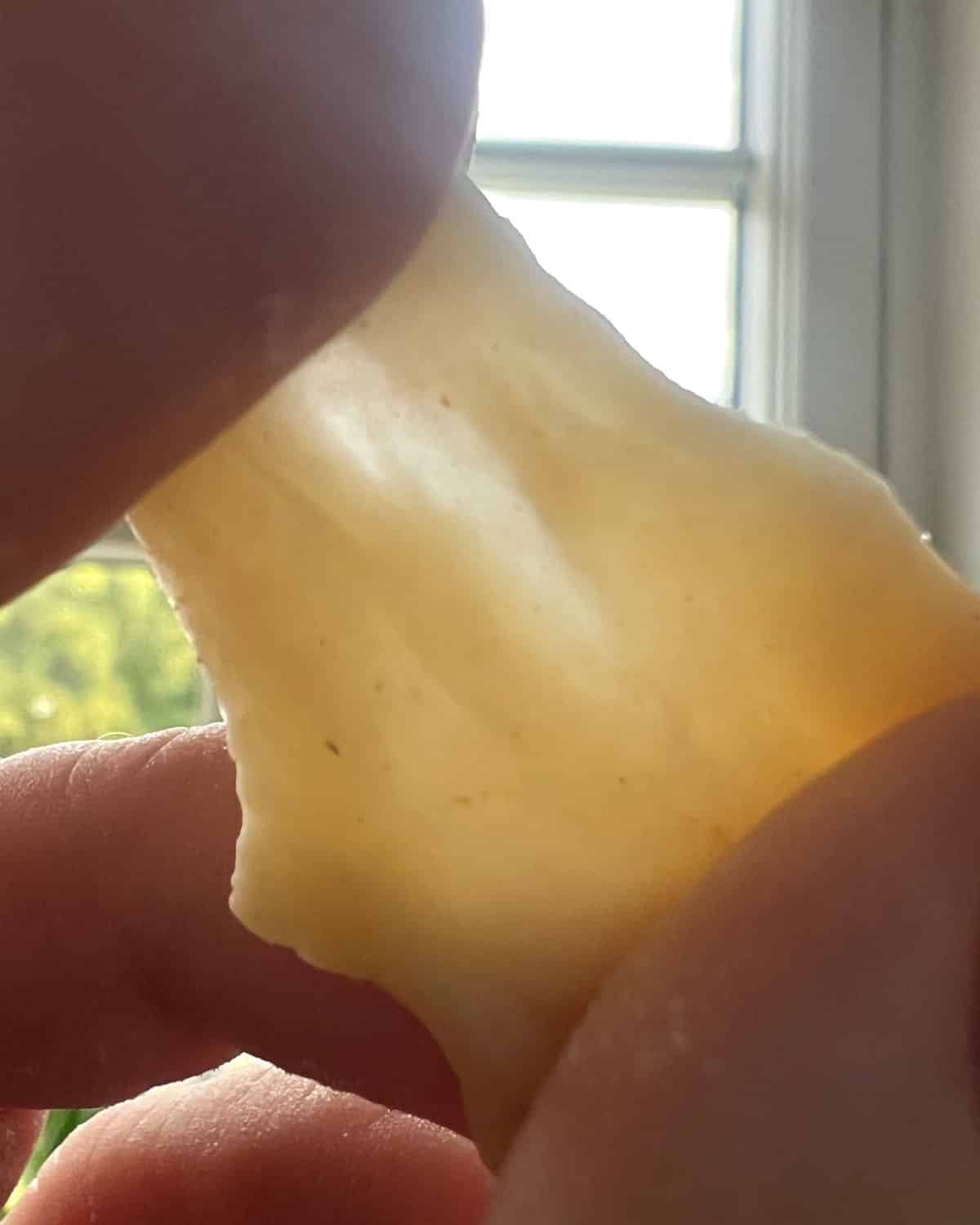
Check if your dough has been kneaded enough by stretching a small piece of it out with your fingers.
If you can stretch it thin enough to see light through it without it tearing, it's ready.
If it tears, knead a little longer.
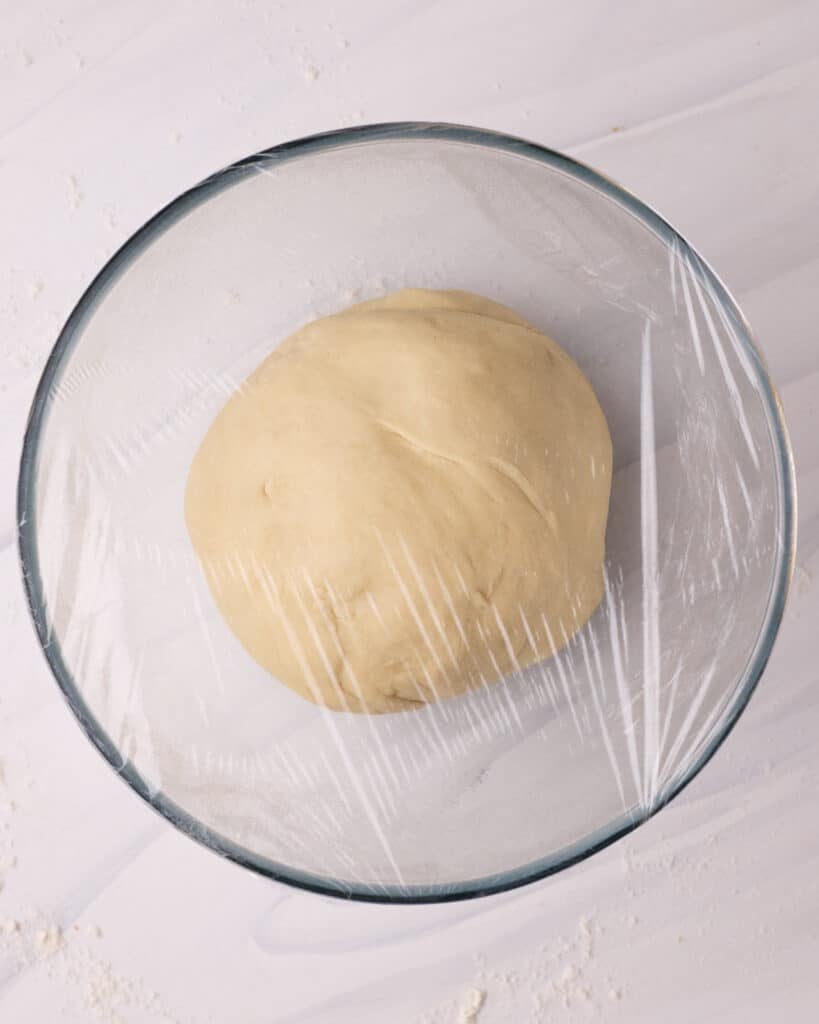
First Rise
Form the donut dough into a smooth ball and place it in a greased bowl.
Cover with plastic wrap and leave it on the countertop or in a warm place until it has doubled in size.
This should take 1-2 hours depending on the room temperature.
How to Test if Dough is Ready
Once your dough ball has doubled in size, you can test if the dough is done proving by pressing it lightly with your finger.
Underproofed dough will bounce back immediately.
Perfectly Proofed dough will come back slowly, and only about halfway so you'll still see a small indent.
Overproofed dough won't spring back at all and may even deflate a little when you touch it.
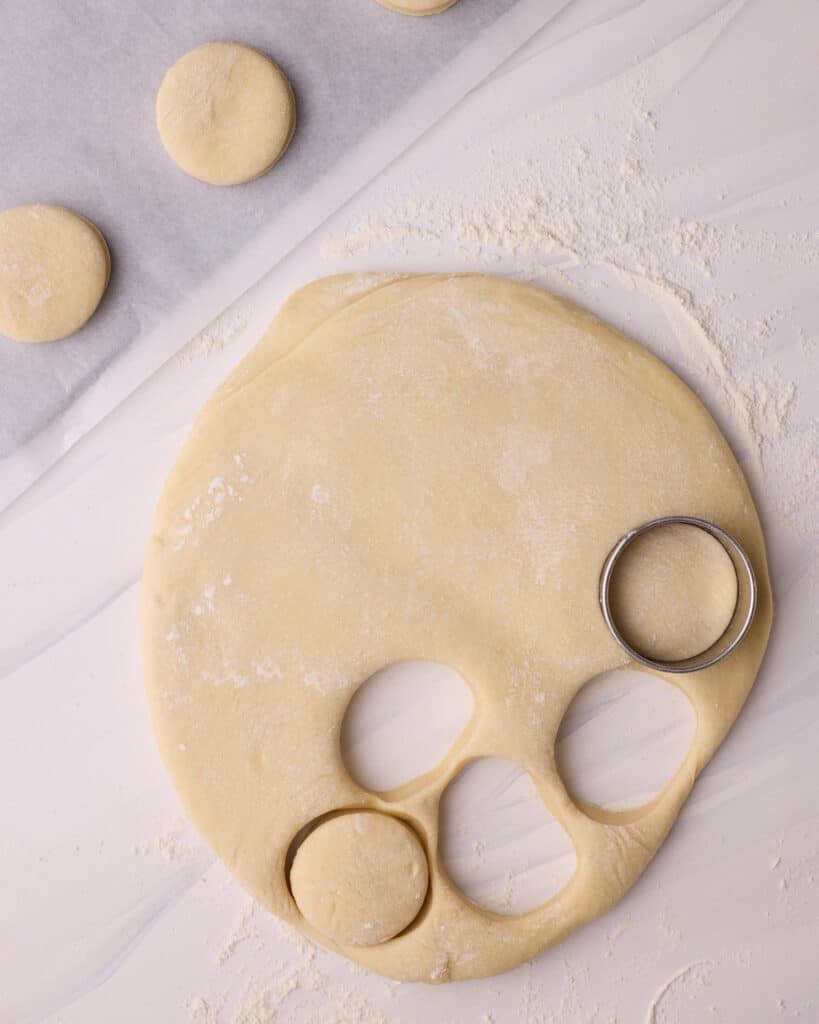
Cut out Donuts
Punch down the dough to release air, then turn it onto a floured surface and roll to ½-inch thick.
Use a 3-inch round cutter to cut out circles, placing them on a parchment paper-lined baking sheet with space between them.
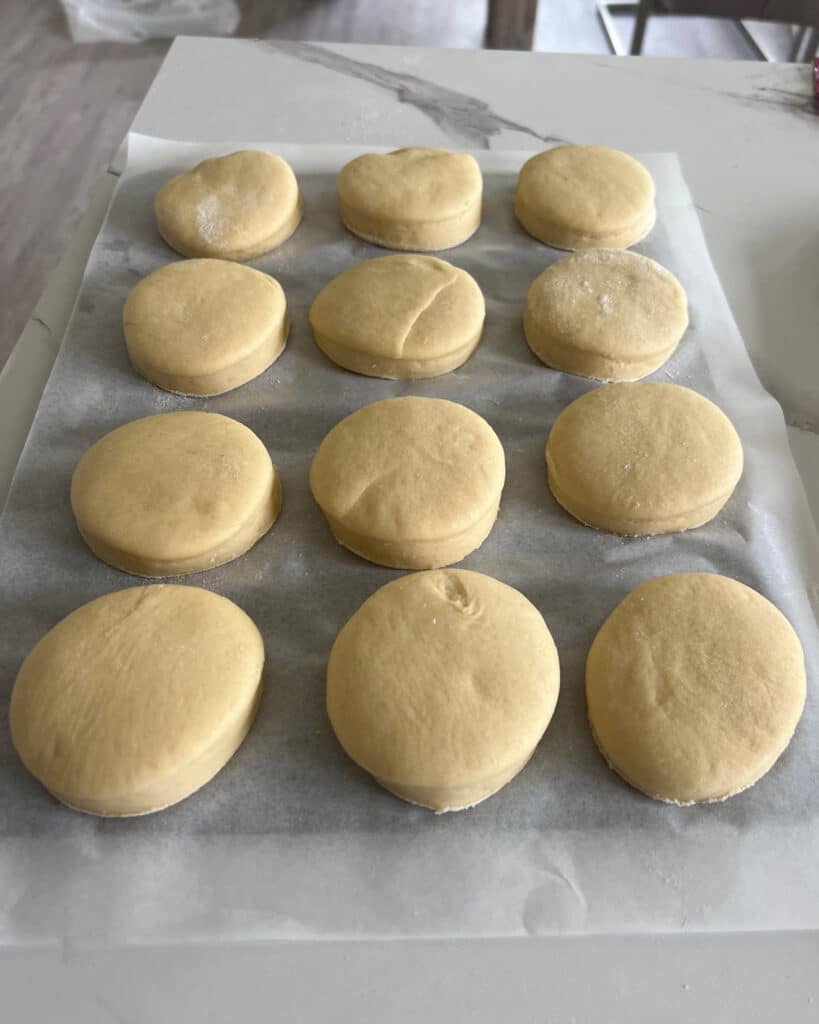
Second Rise
Cover the donuts loosely with plastic wrap or a kitchen towel and let them rise again.
After 45 minutes, check them using the finger test again. If they're not ready, re-cover and check every 10-15 minutes.
Once risen, uncover and begin heating the oil in a large saucepan over medium heat to 340°F (171°C).
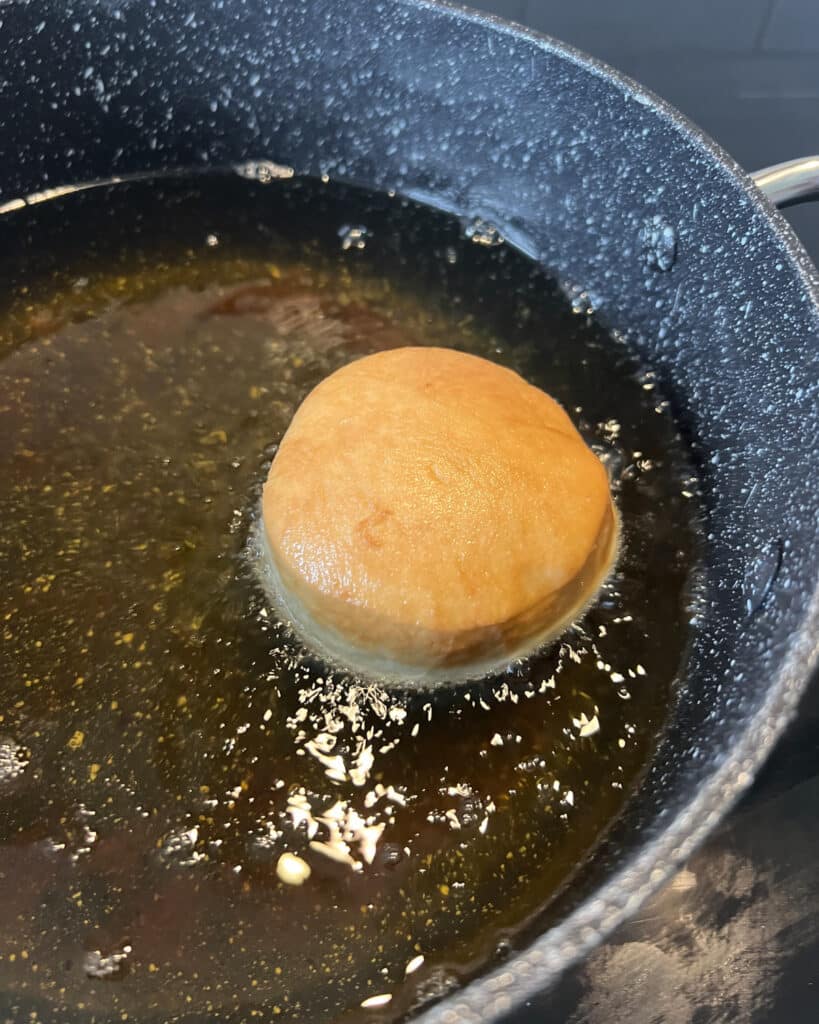
Fry the Donuts
Place a donut in the hot oil and fry until the underside is lightly golden brown.
Flip and fry until the other side is the same color (about 1-2 minutes each side).
Scoop the donut out and lay it on a paper towel-lined wire rack to absorb excess oil.
Fry in batches of 2-3 donuts, allowing the oil to return to temperature between batches.
Top Tips for Frying Donuts
Oil Temperature
The temperature of the oil is crucial for perfectly fried donuts. While many donut recipes call for 375°F, my testing shows that a range between 325°F and 350°F works best for this recipe.
If the oil is too hot, the outside browns too quickly, and if it's too cool, the donuts absorb excess oil. Use a thermometer to maintain the right temperature, letting the oil reheat between batches.
Thermometer Placement
For an accurate reading, position the thermometer in the middle of the oil, not touching the bottom of the pan. (Unless you are using a candy thermometer - they are designed with this in mind). If you're using a probe thermometer, hold it in the oil without letting it touch the pan.
Avoid Dents
If your donuts are getting indented when you pick them up, cut the parchment paper beneath each donut into small squares and use these to place them on a spoon. Gently lower the spoon into the oil while holding a corner of the paper, allowing the donut to slide off without being touched.
Prepare in Advance
Working with hot oil is easier if you're organized. While the donuts are on their second rise, set up your frying station with a thermometer, a cooling rack lined with paper towels, and a plate by the stove for resting your spoon between batches.
Knowing When Donuts Are Done
Donuts will bubble a lot when they first hit the hot oil - once the bubbling slows down, check the bottom for a light golden brown color. They will continue to darken slightly after they come out of the oil, so don't brown them too much.
Cooking times vary depending on factors like oil temperature and dough thickness. Mine typically take roughly 80 seconds on the first side and 1 minute on the second. Fry the first few donuts one at a time until you find the right timing.
Fill and Glaze the Donuts
The creamy custard filling and rich chocolate glaze are what make these Boston Cream Donuts. They kind of remind me of giant profiteroles! Wait until the donuts have cooled completely before trying to fill or glaze them, otherwise your delicious pastry cream will melt.
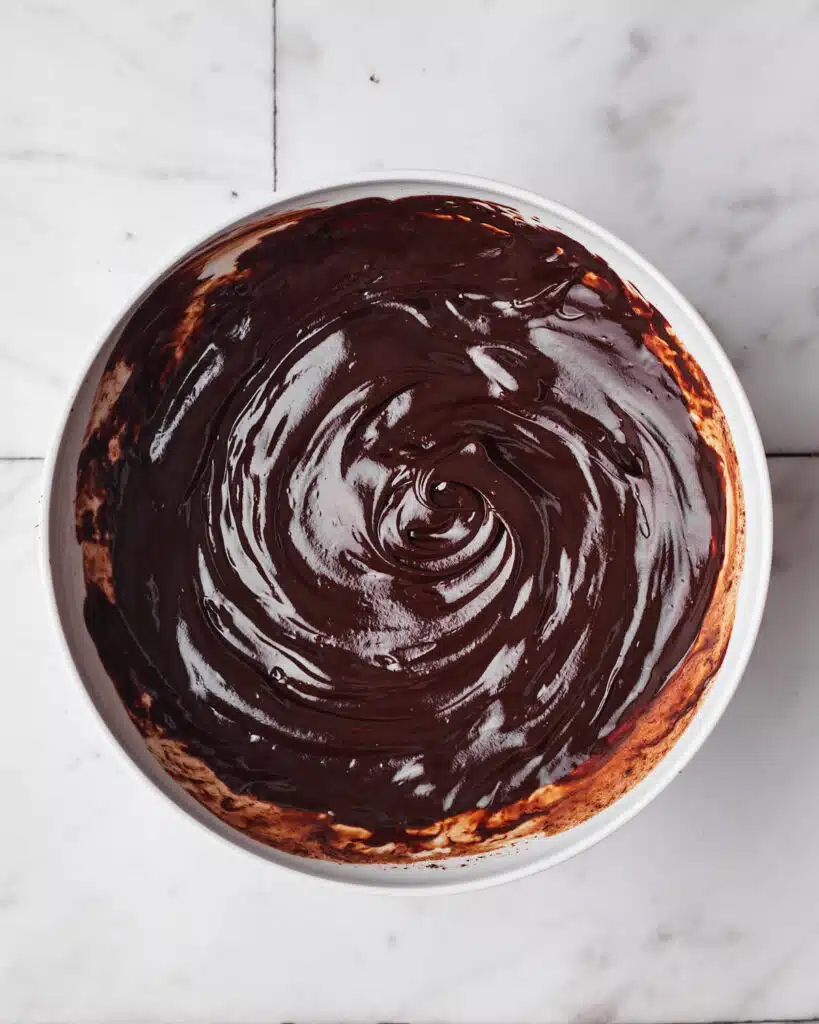
Make the Ganache
Heat the cream until it is scalding hot and then pour it over the chopped chocolate.
Let sit for a minute, then stir until the chocolate is fully melted and you have a smooth chocolate ganache glaze.
Let it cool down slightly while you fill the donuts.
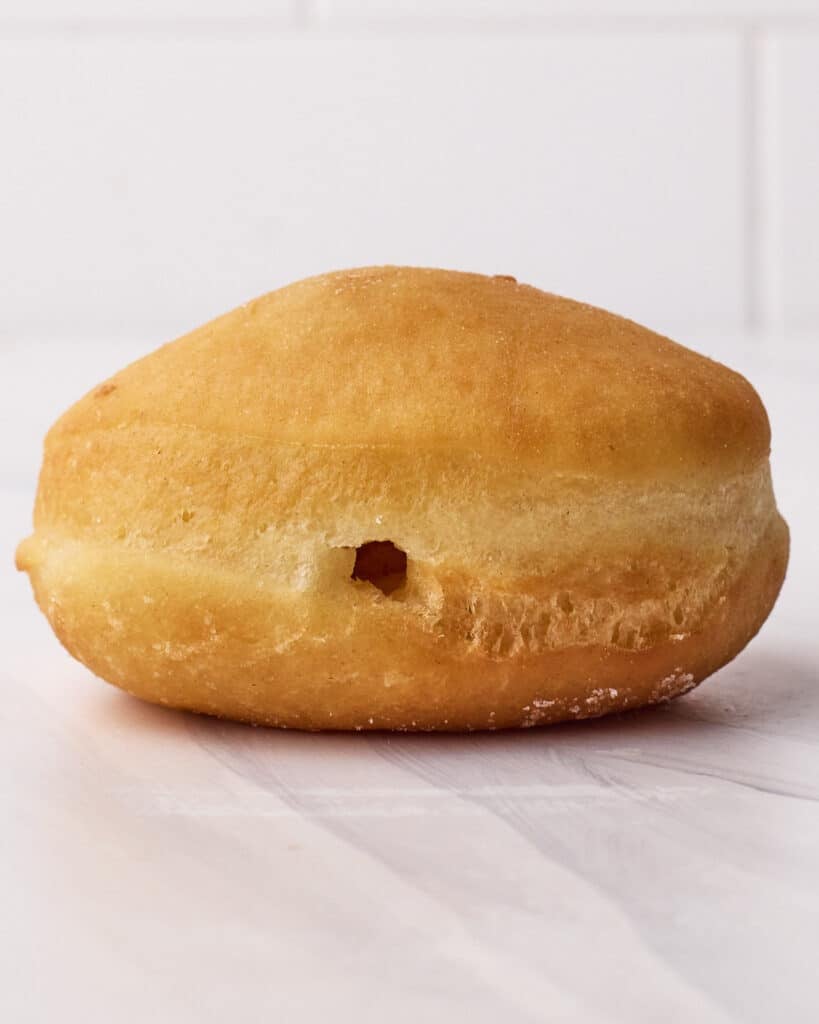
Make Room
Poke a hole in the side of the donut with a thin object like a chopstick or metal straw, and move it around inside to make space for the filling.
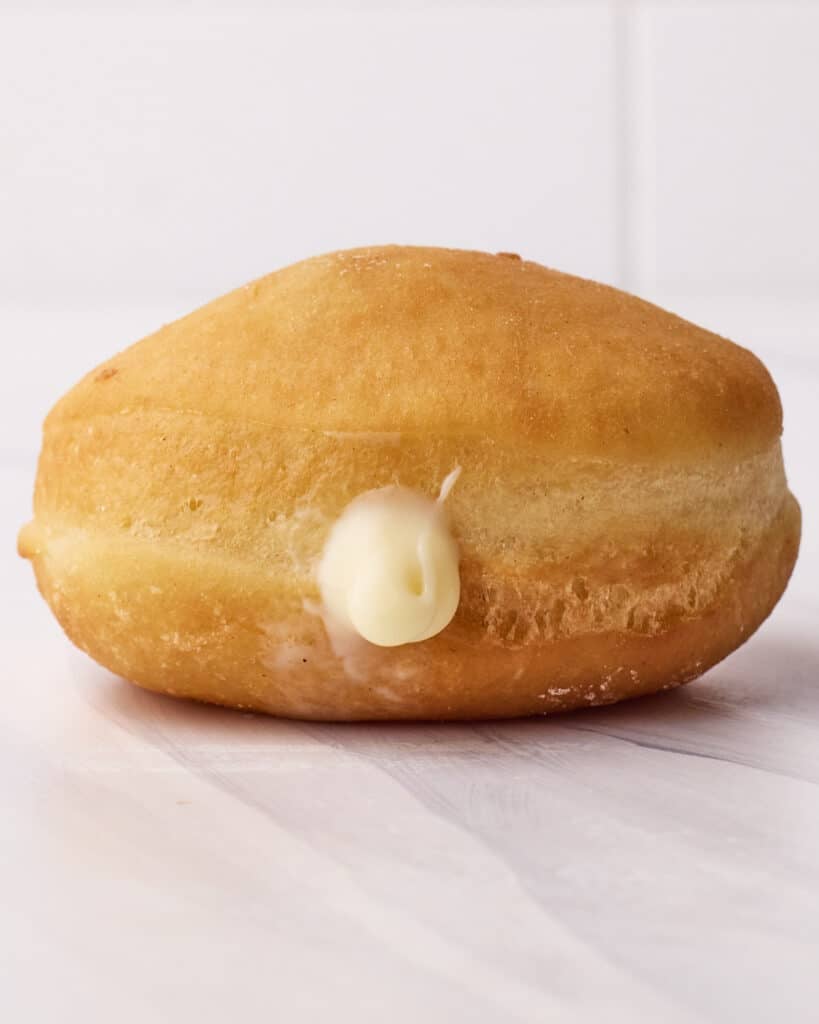
Fill the Donuts
Take the pastry cream out of the fridge and whisk it a little to bring the creamy texture back.
Put it in a piping bag with any kind of tip and gently squeeze the custard into the donut until it starts to feel heavy.
Slowly pull the piping bag out of the donut, leaving a little bit of pastry cream showing.
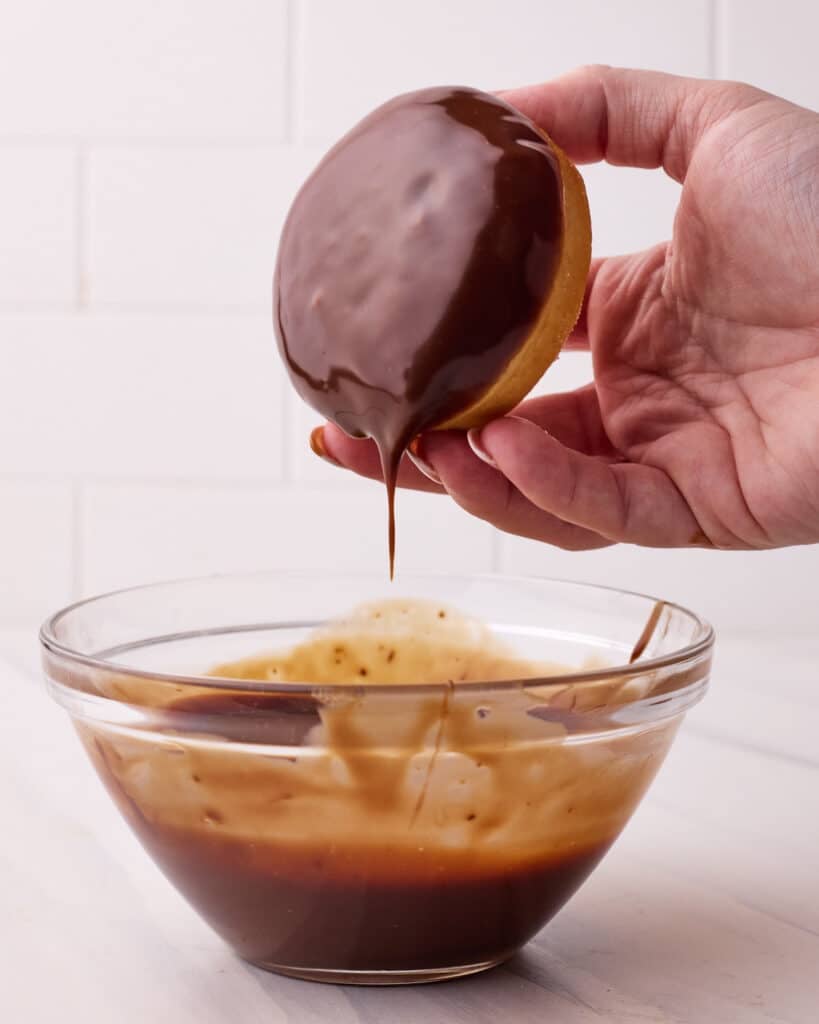
Glaze
Dip the top of a donut into the chocolate ganache, gently shake off any excess glaze, and put it on a baking sheet to set.
If the ganache is too runny, let it cool for 5-10 minutes until it reaches the right consistency.
Repeat with all the donuts.
Troubleshooting
Here are some of the most common problems that arise when making Boston cream donuts, and how to avoid them:
Yeast not frothing up
If your yeast mixture isn't frothing up then your yeast is likely dead and you'll need to buy more.
Flat Donuts
If your donuts deflate on the second rise or while frying they were probably over-proofed, either due to rising too long or being kept in an overly warm spot. Proofing in a warm oven may also lead to over-proofing and collapse.
Yeast doughs need some warmth to rise, but too much can cause excess air, making them prone to collapse. Room temperature is typically fine unless you're in a very hot climate.
Donuts are raw inside
Raw centers usually mean the oil was too hot, browning the outside before the insides could fully cook.
Dense Donuts
If donuts turn out dense or don't puff up when frying, they were likely under-proofed.
Oily Donuts
Excessively oily donuts are usually a result of frying in oil that's not hot enough. When this happens, the donuts stay in the oil for longer, absorbing excess oil.
Fluctuating Oil Temperature
If you're struggling to keep the oil temperature steady, try adding more oil-a larger volume will be less prone to temperature fluctuations.
It can take a few tries to find the right heat level that keeps the oil gently rising back to temperature without drastic swings. Expect some cooling each time donuts are added, but a gradual rise can help you find a consistent frying rhythm.
Something else?
Have a different problem with your donuts? Feel free to ask in the comments, and I'll help you troubleshoot!
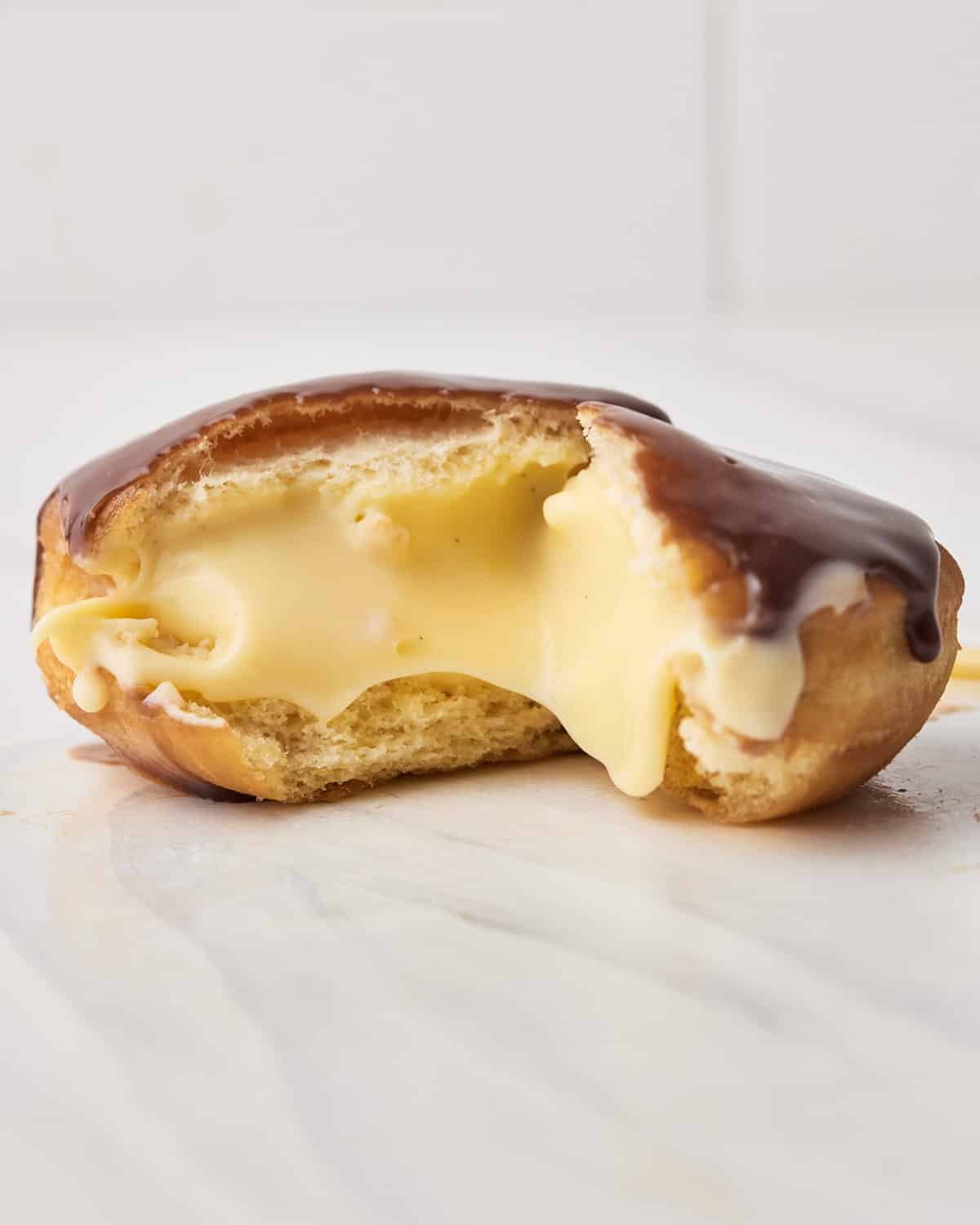
Variations
- Flavored Fillings - Classic Boston cream donuts are filled with vanilla pastry cream, but you could try different fillings, like Pistachio Pastry Cream, or Pumpkin Curd.
- Bavarian Cream Donuts - Make these into Bavarian cream-filled donuts with just a few small tweaks. (You could even make both kinds from the same batch).
- Festive Decoration - Before the ganache sets, top it with some festive sprinkles to make fun holiday donuts.
Equipment
I avoided making homemade donuts for the longest time because I thought you needed special equipment like a deep fryer, but they are so easy to make with regular tools that you have at home already.
- Stand Mixer - with dough hook attachment
- Large Bowl
- Large Pot or Pan
- Small Saucepan
- Whisk
- Rolling Pin
- Round Cookie Cutter
- Metal Slotted Spoon
- Thermometer
- Piping Bag - with star or round tip
- Heat-proof Bowl
- Small Bowl
Storage
Fresh Boston Cream Doughnuts are best enjoyed on the same day you make them as the texture is not as good the next day.
If you do have leftovers, store them in the refrigerator in an airtight container for up to 2 days.
FAQ
If you have a question about this recipe that isn't answered here, feel free to write it in the comment section and I will get back to you as soon as I can.
The filling in Boston cream donuts is vanilla pastry cream. It is a thick custard filling, also known as creme patissier.
Boston cream donuts are the donut version of Boston Cream Pie, which is a sponge cake with custard filling and a chocolate glaze, invented in Boston in 1856.
Boston cream donuts are filled with pastry cream and topped with chocolate glaze.
Bavarian cream donuts have a lighter filling of Bavarian cream (pastry cream folded with whipped cream) and are coated in regular or powdered sugar.
Yes absolutely. You don't have to use a stand mixer to knead the dough, I just find it easier and faster.
If you want to you can knead the dough by hand, it will just take a lot longer.
This recipe can be made with either active dry yeast or instant yeast.
If you use instant yeast there is no need to activate the yeast in warm milk first, you can just add it straight into your bowl with the wet ingredients.
Honestly, fried donuts are usually best enjoyed fresh. They would still be safe to eat the next day but they will have lost some of the lovely fluffy texture and won't taste as good.
However, you can make the filling in advance and use the overnight proofing method for the donut dough (see below).
You can let the dough do the first rise overnight in the fridge.
The cold temperature slows down the fermenting process of the yeast and allows the dough to rise slowly, so you still get a lovely fluffy donut dough but over a longer period of time.
To do this, after you have placed your dough in the oiled bowl and covered it, put it straight in the fridge for 8-10 hours.
When you are ready to shape your donuts the next day, let the bowl sit on the counter for about 40 minutes to warm up before you roll it out.
More Custard Recipes
If you're all about the custard filling in these donuts, you might enjoy some of these other custard based desserts:
Recipe
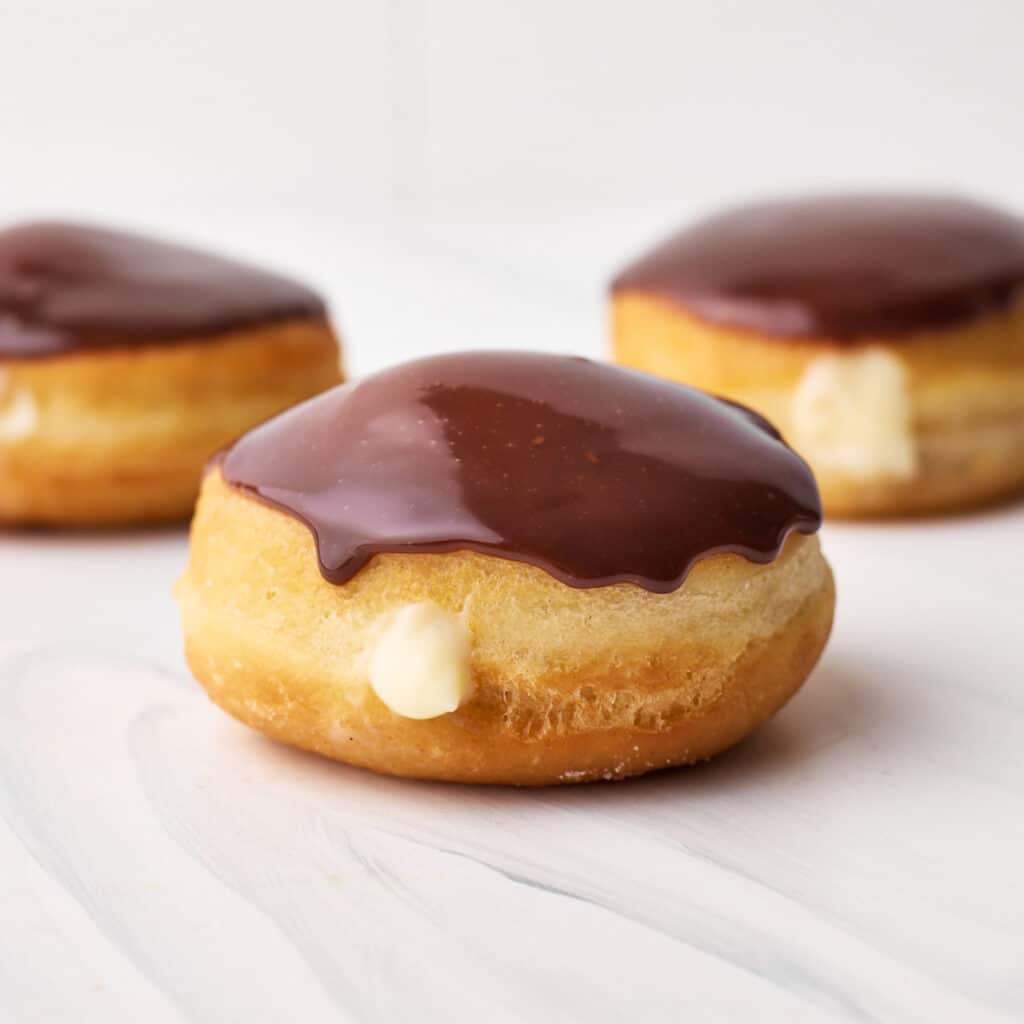
Boston Cream Donuts
Ingredients
- 3 Large Egg Yolks
- ¼ cup Granulated Sugar 50g
- 1 cup Whole Milk 240ml
- 2 tablespoon Cornstarch
- 1 teaspoon Vanilla Extract
- ⅓ stick Unsalted Butter 38g
- 5 cups All-purpose Flour 600g
- ½ cup Granulated Sugar 100g (plus extra for coating)
- 2 packs Active Dry Yeast 14g (or instant yeast*)
- 1 cup Whole Milk 240ml (room temperature)
- 2 Large Eggs (room temperature)
- ⅔ stick Unsalted Butter 80g (melted)
- 1 teaspoon Salt
- Vegetable Oil for frying
- 8 oz Semi-sweet Chocolate 225g (chopped)
- ½ cup Heavy Cream 120ml
Equipment
- Medium Saucepan
- Stand Mixer with dough hook attachment
- Round Cookie Cutter 21/2 - 3 inches wide
Instructions
- Note: Make the pastry cream filling ahead of time, at least two hours before it is needed so it has time to chill. For more in-depth instructions and step-by-step process shots, see my post on how to make pastry cream.
- Whisk the egg yolks together with the cornstarch and sugar.3 Large (3) Egg Yolks, 2 tablespoon Cornstarch, ¼ cup (50 g) Granulated Sugar
- Pour the milk and vanilla into a saucepan and heat over medium-low heat.1 cup (240 ml) Whole Milk, 1 teaspoon Vanilla Extract
- Once the milk begins to steam, drizzle it slowly into the egg yolk mixture, whisking it in to combine as you go. It's important to do this gradually to slowly bring up the temperature of the egg yolks so they don't scramble.
- Once all the milk has been added, pour the whole mixture back into the saucepan and continue to cook, stirring gently but constantly, until the pastry cream begins to boil.
- Once you see thick bubbles boiling on the surface of the cream, boil for 1-2 minutes until the pastry cream has thickened. Whisk the whole time so the custard doesn't burn.
- Remove from the heat. If you have warmed it slowly, then there shouldn't be any lumps in the pastry cream, but if you do have some lumps, pass the pastry cream through a fine mesh sieve to remove them.
- Whisk in the butter, one tablespoon at a time, making sure it has completely melted in before adding the next.⅓ stick (38 g) Unsalted Butter
- Cover with plastic wrap, so the plastic is touching the surface of the pastry cream, and let cool. Then refrigerate until needed (at least 2 hours).
- Warm the milk to roughly body temperature and mix in the active dry yeast and 1 tablespoon of the sugar. Let it sit for 5-10 minutes or until it starts to froth up.If you are using instant yeast, you can skip this step.1 cup (240 ml) Whole Milk, 2 packs Active Dry Yeast
- In the bowl of a stand mixer with a dough hook attachment, add the remaining sugar, salt, and eggs.½ cup (100 g) Granulated Sugar, 2 Large (2) Eggs, 1 teaspoon Salt
- Once the yeast is frothy, pour the milk/yeast mixture into the mixer bowl and stir everything together to combine.
- Add the flour and turn the mixer on low speed for 1 minute until it incorporates slightly.5 cups (600 g) All-purpose Flour
- With the mixer still on low speed, slowly drizzle in the melted butter.⅔ stick (80 g) Unsalted Butter
- Turn the mixer up to high speed and let it mix for 3-5 minutes or until the dough is no longer sticking to the side of the bowl. If it seems too sticky, you can add another 1-2 tablespoons of flour.
- Tip the dough out onto a lightly floured work surface and knead it by hand until it is no longer sticking to your hands. You can do the windowpane test to see if it has been kneaded enough.*
- Form the dough into a smooth ball and place it in an oiled bowl. Cover with plastic wrap and leave it on the countertop to rise until it has doubled in size (1-2 hours, depending on the temperature of your kitchen.
- Once the dough has doubled in size, check if it is ready by pressing on it lightly with your finger. If the indent disappears immediately, it needs longer to prove. If the indent comes back slowly and only about halfway, then it is ready to use.
- Punch the dough to release the excess air, then tip it onto a floured work surface and roll it out to ½ an inch thick.
- Use a round cookie cutter (2 ½ - 3 inches wide) to cut rounds out of the dough and place them on a lined baking sheet, with a little space between them. You can re-roll and cut out the scraps, but I don't recommend doing it more than once.
- Cover the donuts loosely with plastic wrap or a kitchen towel and leave to prove again for roughly 45 minutes. Do the indent test again to see if they are ready. If not, check them again at 15-minute intervals.
- Once the donuts are ready, uncover them and start heating up the oil. Make sure the oil in your pan is at least 2-3 inches deep.Vegetable Oil
- Using a candy thermometer, bring the oil to a temperature of 350°F / 180°C.
- Next to your stovetop, set up a wire rack lined with paper towels (this is to absorb the excess oil).
- Test out your first donut by lowering it gently into the oil with a metal slotted spoon. It should start to bubble around the edges.
- Fry the donut until it is a pale golden brown color (it will continue to brown after). Then flip the donut over and fry the other side until it is the same color. This should take about 1-2 minutes per side.
- I find the optimum temperature for frying these donuts is 325° - 340°F ( 165° - 171°C). Make sure you let the oil come back up to temperature in between donuts, as it may cool down as you are frying.
- Remove the donut from the oil and place it on the wire rack lined with paper towels.
- Repeat with all the donuts. I recommend frying just 2 or 3 at a time, as they do fry so quickly.
- Let the donuts cool completely before filling and glazing.
- Make the ganache glaze right before you fill the donuts so it has time to cool slightly and will be ready to dip the filled donuts into. Heat the cream in a saucepan until it is steaming but not boiling, then pour over the chopped chocolate and let sit for 1 minute.½ cup (120 ml) Heavy Cream, 8 oz (225 g) Semi-sweet Chocolate
- Stir the chocolate and cream until all the chocolate has melted and the ganache is smooth and glossy.
- Take the pastry cream out of the fridge, whisk it a little to bring the texture back, and then transfer it to a piping bag with any kind of tip.
- Use a long, thin object like a chopstick or a metal straw to poke a hole in the side of each donut and move it around to create space in the middle.
- Gently squeeze a generous amount of pastry cream into each donut. Once the donut feels heavy, you will know it is full.
- Dip each filled donut into the chocolate ganache, shake gently to get rid of any excess, and set them down on a baking sheet to set.


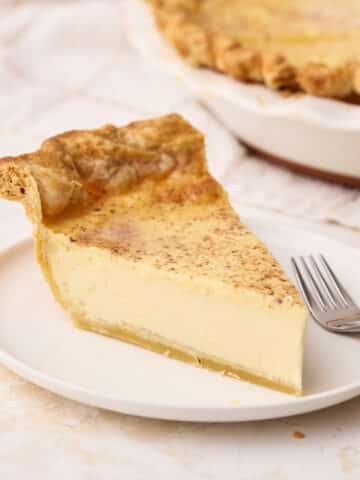
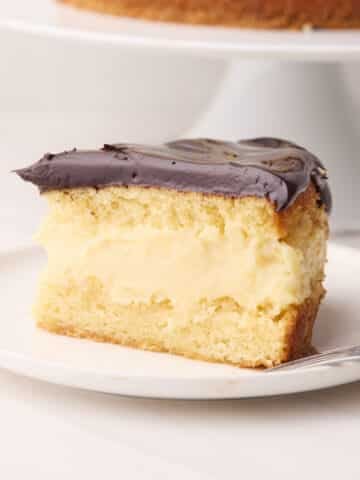
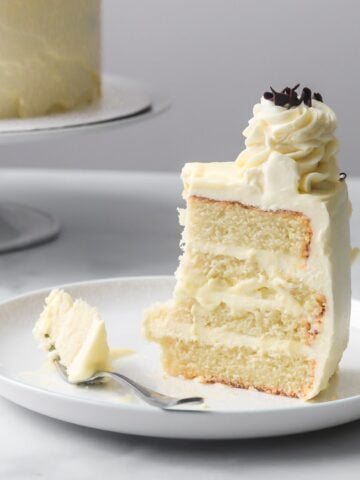
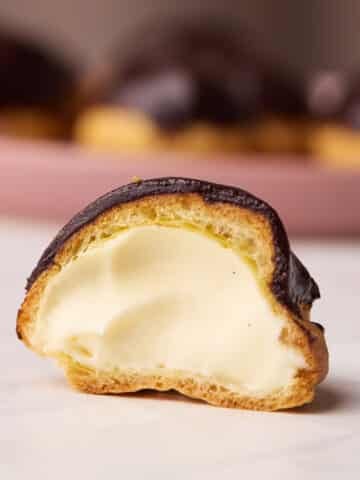

Joe
Can you do the first proof overnight for this recipe? Do you recommend less yeast?
Jules Grasekamp
Hi Joe,
Yes you can! I have instructions for how to do this in the FAQ section on the post.
I use the same amount of yeast.
Thanks
Jules
Chris Radwanski
As someone who had never tried a homemade donut until adulthood, I feel like its my duty to tell you all to MAKE THESE! Seriously, I could sit down and eat these for a meal and not feel bad about it. What a mind boggling difference homemade donuts makes. DE-LICIOUS!!